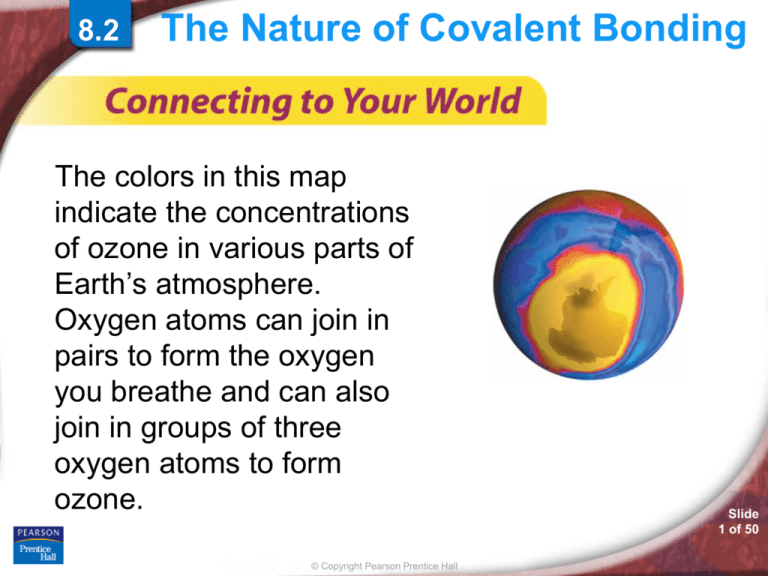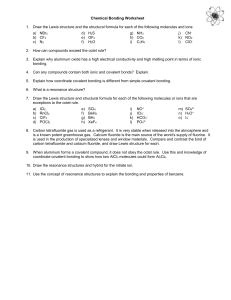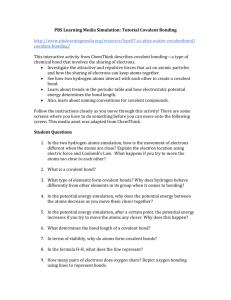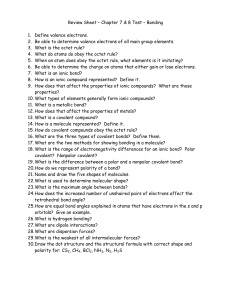
8.2
The Nature of Covalent Bonding
The colors in this map
indicate the concentrations
of ozone in various parts of
Earth’s atmosphere.
Oxygen atoms can join in
pairs to form the oxygen
you breathe and can also
join in groups of three
oxygen atoms to form
ozone.
© Copyright Pearson Prentice Hall
Slide
1 of 50
8.2
The Nature of
Covalent Bonding
>
The Octet Rule in Covalent Bonding
In covalent bonds, electron sharing
usually occurs so that atoms attain the
electron configurations of noble gases.
Slide
2 of 50
© Copyright Pearson Prentice Hall
8.2
The Nature of
Covalent Bonding
>
Single Covalent Bonds
Two atoms held together by sharing a pair of
electrons are joined by a single covalent bond.
Slide
3 of 50
© Copyright Pearson Prentice Hall
8.2
The Nature of
Covalent Bonding
>
Single Covalent Bonds
The halogens form single covalent bonds in their
diatomic molecules. Fluorine is one example.
Slide
4 of 50
© Copyright Pearson Prentice Hall
8.2
The Nature of
Covalent Bonding
>
Single Covalent Bonds
A pair of valence electrons that is not shared
between atoms is called an unshared pair, also
known as a lone pair or a nonbonding pair.
Slide
5 of 50
© Copyright Pearson Prentice Hall
8.2
The Nature of
Covalent Bonding
>
Single Covalent Bonds
The hydrogen and oxygen atoms in water attain
noble-gas configurations by sharing electrons.
Slide
6 of 50
© Copyright Pearson Prentice Hall
8.2
The Nature of
Covalent Bonding
>
Double and Triple Covalent Bonds
A bond that involves two shared pairs of
electrons is a double covalent bond.
Ex O2
Slide
7 of 50
© Copyright Pearson Prentice Hall
The Nature of
Covalent Bonding
>
A bond that involves three pairs of shared electrons is called
a triple covalent bond
Ex N2
Slide
8 of 50
© Copyright Pearson Prentice Hall
The Nature of
Covalent Bonding
>
Electron Dot Structures
Rules for Drawing Lewis Structures:
1. Count valence electrons for entire
molecule
ex NH3
Slide
9 of 50
© Copyright Pearson Prentice Hall
The Nature of
Covalent Bonding
>
2. Draw skeleton structure, connecting all
atoms with single bonds (think
symmetry!!!)
Slide
10 of 50
© Copyright Pearson Prentice Hall
The Nature of
Covalent Bonding
>
3. Add unshared pairs of electrons to give
all atoms an octet. (Remember
Hydrogen only gets 2 electrons)
Slide
11 of 50
© Copyright Pearson Prentice Hall
The Nature of
Covalent Bonding
>
4. Count total electrons in molecule. If this
number equals number of electrons
from step #1, you’re done. If not, you
must make double or triple bonds.
Slide
12 of 50
© Copyright Pearson Prentice Hall
The Nature of
Covalent Bonding
>
Try these:
1 . CO
2. COH2
3. CHCl3
4. HCN
Slide
13 of 50
© Copyright Pearson Prentice Hall
The Nature of
Covalent Bonding
>
Slide
14 of 50
© Copyright Pearson Prentice Hall
8.2
The Nature of
Covalent Bonding
>
Double and Triple Covalent Bonds
Slide
15 of 50
© Copyright Pearson Prentice Hall
8.2
The Nature of
Covalent Bonding
>
Double and Triple Covalent Bonds
Carbon dioxide gas is soluble in water and is
used to carbonate many beverages. A carbon
dioxide molecule has two carbon-oxygen double
bonds.
Slide
16 of 50
© Copyright Pearson Prentice Hall
8.2
The Nature of
Covalent Bonding
>
Double and Triple Covalent Bonds
Carbon dioxide is an example of a triatomic
molecule.
Slide
17 of 50
© Copyright Pearson Prentice Hall
8.2
The Nature of
Covalent Bonding
>
Coordinate Covalent Bonds
In carbon monoxide, oxygen has a stable
configuration but the carbon does not.
Slide
18 of 50
© Copyright Pearson Prentice Hall
8.2
The Nature of
Covalent Bonding
>
Coordinate Covalent Bonds
As shown below, the dilemma is solved if the
oxygen donates one of its unshared pairs of
electrons for bonding.
Slide
19 of 50
© Copyright Pearson Prentice Hall
8.2
The Nature of
Covalent Bonding
>
Coordinate Covalent Bonds
A polyatomic ion, such as NH4+, is a tightly
bound group of atoms that has a positive or
negative charge and behaves as a unit.
Most plants need nitrogen that is already
combined in a compound to grow.
Slide
20 of 50
© Copyright Pearson Prentice Hall
The Nature of
Covalent Bonding
>
Slide
21 of 50
© Copyright Pearson Prentice Hall
8.2
The Nature of
Covalent Bonding
>
Coordinate Covalent Bonds
Slide
22 of 50
© Copyright Pearson Prentice Hall
8.2
Section Assessment
Slide
23 of 50
© Copyright Pearson Prentice Hall
Practice Problems for Conceptual Problem 8.2
Section Assessment
Slide
24 of 50
© Copyright Pearson Prentice Hall
8.2
The Nature of
Covalent Bonding
>
Bond Dissociation Energies
Bond Dissociation Energies
How is the strength of a covalent bond
related to its bond dissociation energy?
Slide
25 of 50
© Copyright Pearson Prentice Hall
8.2
The Nature of
Covalent Bonding
>
Bond Dissociation Energies
The energy required to break the bond between
two covalently bonded atoms is known as the
bond dissociation energy.
A large bond dissociation energy
corresponds to a strong covalent bond.
Slide
26 of 50
© Copyright Pearson Prentice Hall
8.2
The Nature of
Covalent Bonding
>
Resonance
Ozone in the upper
atmosphere blocks
harmful ultraviolet
radiation from the sun.
At lower elevations, it
contributes to smog.
Slide
27 of 50
© Copyright Pearson Prentice Hall
8.2
The Nature of
Covalent Bonding
>
Resonance
The actual bonding of oxygen atoms in
ozone is a hybrid, or mixture, of the
extremes represented by the resonance
forms.
Slide
28 of 50
© Copyright Pearson Prentice Hall
8.2
The Nature of
Covalent Bonding
>
Resonance
A resonance structure is a structure that
occurs when it is possible to draw two or more
valid electron dot structures that have the same
number of electron pairs for a molecule or ion.
Slide
29 of 50
© Copyright Pearson Prentice Hall
8.2
The Nature of
Covalent Bonding
>
Exceptions to the Octet Rule
Exceptions to the Octet Rule
There are molecules in which an atom
has fewer, or more, than a complete
octet of valence electrons.
Slide
30 of 50
© Copyright Pearson Prentice Hall
8.2
The Nature of
Covalent Bonding
>
Exceptions to the Octet Rule
The electron dot structure for PCl5 can be written
so that phosphorus has ten valence electrons.
Slide
31 of 50
© Copyright Pearson Prentice Hall
8.2 Section Quiz.
Assess students’ understanding
of the concepts in Section 8.2.
Continue to:
-or-
Launch:
Section Quiz
Slide
32 of 50
© Copyright Pearson Prentice Hall
8.2 Section Quiz.
1. In covalent bonding, atoms attain the
configuration of noble gases by
a. losing electrons.
b. gaining electrons.
c. transferring electrons.
d. sharing electrons.
Slide
33 of 50
© Copyright Pearson Prentice Hall
8.2 Section Quiz
2. Electron dot diagrams are superior to
molecular formulas in that they
a. show which electrons are shared.
b. indicate the number of each kind of atom in
the molecule.
c. show the arrangement of atoms in the
molecule.
d. are easier to write or draw.
Slide
34 of 50
© Copyright Pearson Prentice Hall
8.2 Section Quiz
3. Which of the following molecules would
contain a bond formed when atoms share
three pairs of electrons?
a. Se2
b. As2
c. Br2
d. Te2
Slide
35 of 50
© Copyright Pearson Prentice Hall
END OF SHOW








